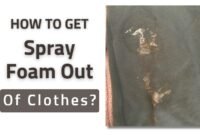Expanding foam, commonly called spray foam sealer, is widely used in insulating buildings and sealing cracks to prevent cold air from entering.
While spray foam is excellent at halting heat transmission, removing spray foam insulation from your hands can be challenging due to its strong adherence to the skin.
Then the burning question is how to get foam insulation off hands? Keep on reading!
A Step-By-Step on How to Get Foam Insulation Off Hands
Various techniques can be employed to remove foam insulation from the skin, but it’s crucial to act while the foam is still wet. Once dry, removing it will necessitate using a powerful solvent like isopropyl alcohol, another chemical, or vigorous rubbing with an abrasive object such as a pumice stone nail file or an emery board.

- While Still Wet, Wipe Off Excess Foam
Dry spray foam is harder to get rid of than wet foam. Use a paper towel or a disposable cloth to remove spray foam from your hands. When finished, make sure to throw away the cloth or paper towel. The foam will attach to another surface if this doesn’t happen.
Read also: How to Remove Cured Spray Foam from Hands
- Apply Powder
After drying your hands, use a generous amount of baby powder and gently knead it into your hands for a few minutes. How much spray foam you need to remove spray foam from hands will determine how much powder you apply. It would be best if you used a lot of it.
When you rub your hands together, part of the spray foam that has adhered to the baby powder will fall off. To get the spray foam and baby powder off your hands, wash them. To remove all the spray foam from your hands, repeat this process a few times.
- Use Acetone to Treat the Impacted Areas
Spray foam turns into a liquid upon contact with acetone. Even after wiping off the excess, remnants of foam insulation may linger on your skin. To remove the foam from your skin and loosen its grip, apply acetone or use isopropyl alcohol as an alternative solvent.
The next procedure for removing foam insulation from hands is to use paper towels or a disposable piece of cloth to clean it off. Whether you need acetone and are unsure where to get it at home, see if you have a nail polish remover that contains acetone as the main component.
- Use Warm, Soapy Water to Wash Your Hands
Acetone can irritate the skin, causing dryness and potential cracking due to its oil and moisture-absorbing properties. However, if acetone or isopropyl alcohol comes into contact with your skin for a short duration, it’s generally safe. After using these solvents, applying a moisturizer like Vaseline petroleum jelly can help restore your skin’s natural oils.
To get rid of the acetone, properly wash your hands. Wash your hands gently with warm water and soap to get the acetone off.
- Moisturize Your Hands
Dry your hands and moisturize them. The lotion will replace the oils lost when you rub acetone on your hands. Don’t skip this step, especially if you suffer from contact dermatitis. Make careful to look for dried spray foam on your hands. If you fail to get it all out, it will get dried. You can get spray foam off your hands with the following steps.
How do you get dried foam insulation off your hands?
It’s not as difficult as most people think to remove dried spray foam from your hands and skin after performing house maintenance, repairs, and other handyman tasks. In truth, there are several ways to clean your hands and skin with dried spray foam.
- Rub It Off with a Pumice Stone
You’ll need to attempt several techniques since hardened spray foam that has been cured is typically rugged to remove. Spray polyurethane foam is highly sticky in this form. Thus more work is required to remove it.
If your skin remains dry after attempting to remove spray foam insulation, liberally apply Vaseline petroleum jelly to your hands. Wrap your hands in plastic for an hour to allow the jelly to penetrate and soften the foam residue, then wash them with warm water.
Read also: Polyurethane Foam Insulation Pros
- Use an Exfoliating Soap or Scrub to Clean Your Hands
An alternative is to manufacture your scrubs at home with oil, sugar, and coffee granules. While the coffee and sugar grains will help you clean it off your hands, the oil will assist in the release of dried spray foam.
- Apply Baking Soda and Vegetable Oil to Your Hands
Rub vegetable or canola oil on your hands. Give your hands a generous coating of baking soda and massage them for a few minutes.
If you don’t have baking soda, use sugar or sea salt instead. You can then wash your hands with warm water and soap. Apply lotion to keep your hands from drying out.
- Put Warm, Soapy Water-Filled Gloves On and Soak Your Hands in Them
You’ll need to be patient since spray foam may be very obstinate. For at least an hour, wear gloves. Even though your hands will resemble prunes, the unpleasant spray foam on your hands will no longer be an issue.
Wrapping Up
Now that you have learned how to get foam insulation off your hands, note that while some techniques are more successful with wet spray foam, others are more successful with dry foam.
Unfortunately, spray foam is stubborn, especially when cured, so you must use multiple methods to remove it from your hands. Spray foam is regrettably difficult to remove entirely off your hands, especially after it has hardened.


